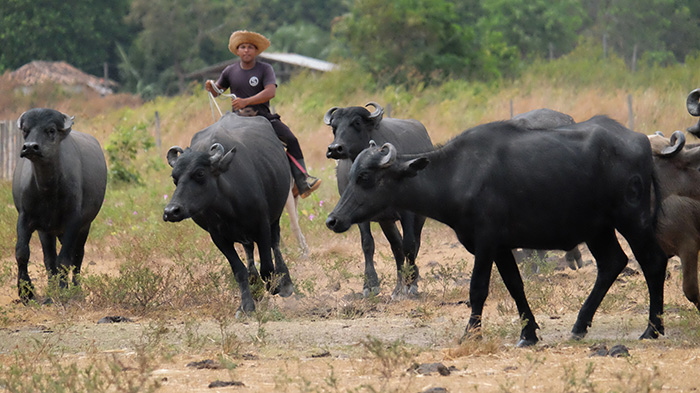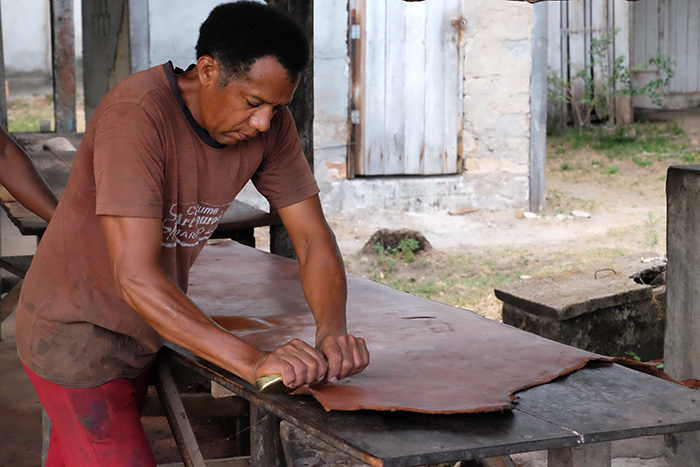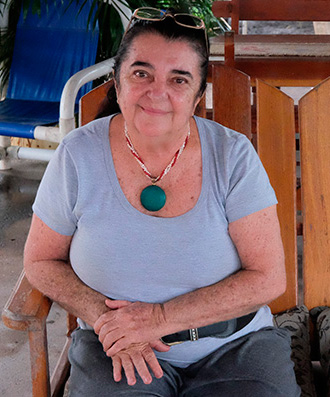Census of Agriculture: Marajo Island is the home of most buffaloes in the country
November 13, 2017 09h00 AM | Last Updated: June 05, 2018 03h50 PM
Agricultural production is extremely important in the generation of labor and income in Pará, where about 230 thousand establishments in 144 thousand municipalities will be visited by the enumerators responsible for the 2017 Census of Agriculture data collection. The state is a major producer of cassava, soybeans and palm oil, and shares with Bahia the position as of main cacao producer in the country. Statistics show us another striking feature: buffalo farming in the Marajó Island.
Located in the north of Paraná, in an area where not even fisherman know how to tell the river and the sea apart, the island holds the biggest inventory of buffaloes in Brazil. According to the IBGE’s Municipal Livestock Survey (PPM), Pará had approximately 520 thousand head (38% of the national total) in 2016, of which more than 320 thousand lived in the northern and northwestern coast of the island. The municipality of Chaves alone has a little more than 30% of the herd in the state, about 160 thousand animals – a lot different from the second municipality in the ranking of number of buffalos, Cotia, in Amapá, with no more than 77 thousand head.

Buffalo breeders guide a herd on the Marajó Island
The municipality of Soure, which houses of the IBGE local units in Marajó, holds the second biggest herd of buffaloes on the island (about 74,500) and it is the tourism capital of the area. Anyone who leaves the Waterway Terminal of Belém in search of beautiful beaches will find there indications that the buffalo moves the economy of the island, from local cuisine to cargo transportation, and is present in a big number of establishments. According to João Paulo da Rocha, vice-president of the Association of Buffalo Farmers of the State of Paraná, estimates indicate that a total 80% of all farmers in the state have up to 200 head, and that same pattern is found on the island.
Buffalo farming is an activity of cattle breeders, for the animals provide meat, milk, rawhide and horns that are used by restaurants, artisans, cheese manufacturers and other type of producer. A tannery in the city sells bags and footwear produced in a two-month long process that includes rawhide treatment, its dying with paint obtained from the Mangrove tree bark and the stretching of rawhide pieces before the artisan receives it. Tourists are amazed to find out that the animals are even part of the Soure police patrol, ant that also makes the local community feel safe.

Preparation of buffalo rawhide on the island
Buffalo farmers do not usually deal with sales of meat, trading only live animals for other live animals with other farmers or with purchasers for slaughtering in tanneries. According to Rocha, from the APCB, the main consumers of meat are the residents of the island, called marajoaras. Belém, the capital, and other cities in the state are also usual destinations, and, out of the state, Amapá, Maranhão and Lebanon. In Soure, most of the slaughtering takes place in the municipal slaughterhouse. “I sell animals, but I do not deal with death”, says Eva Daher Abufaiad, owner of two properties used for buffalo farming. One of the places was inherited from her father, Elias Salomão Abufaiad, a Lebanese descendant who started the family business on the Marajó island more than 70 years ago.

A veterinarian and agronomist, Doctor Eva, as she is known in Soure, supervises buffalo breeding in about one thousand properties that, together, take up an area of more than two thousand hectares. Most of the animals are Murrah or Carabao, two of the four breeds found on the Marajó; the others are Jafarabadi and Mediterraneane and of mixed breeds. Eva is also responsible for the inspections conducted in the slaughterhouse, takes care of the pets of Soure residents and joins investigations at police and Judiciary Power’s request to find missing animals that have been taken to other farms, in Amapá, most often. She says these crimes are not uncommon and cause a lot of damage, but that farmers are not discouraged: “I always say I do not work for money, but for my love for the animals and for nature.”
The property of Eva Abufaiad is among the 1,500 places that will be visited by the Census of Agriculture in the northern half of the Marajó island, but differently from many of them, it has easy access to enumerators. A boat is necessary to reach other buffalo farms, mainly in the floode areas of the island. A curiosity about buffaloes is that they are excellent swimmers; a algend says they first got to Marajó in the last decade of the 19th century, after the ship that was transporting them from the Indochina region (where Vietnam, Laos and Camboja) to the French Guyana sank near the coast. “The official version that we can prove is that the buffaloes were being imported from Italy and India in the 1930's”, says Rocha. Even so, the exotic names of the breeds (Carabao, Murrah, Jafarabadi, among others) came from the legend. When we tell tourists this story they laugh but never question this fantasy version.
Pará has 26 sub-areas, which will receive more than 1,000 enumerators in the field for the 2017 Census of Agriculture data collection. Currently, about 60% of the researchers have been doing the interviews. Up to the beginning of November, one month after the start of the operation, 10% of the establishments had been enumerated, which corresponds to about 20 thousand properties. Interestingly enough, the first questionnaire filled out in this Census edition in Pará came from Soure.
Text (in Portuguese) and photos: Cláudia Sedano, from Pará
Design: Helena Pontes
Infographic: Pedro Vidal


















